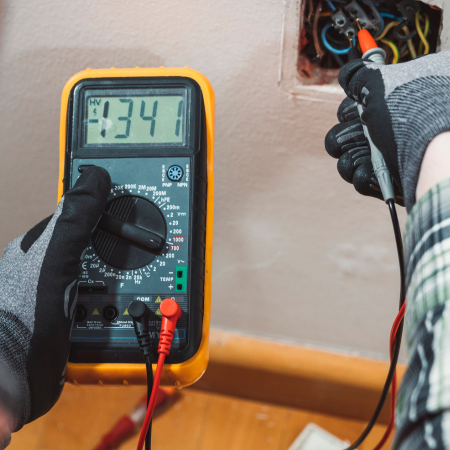- Building
- Timber
- Plumbing
- Kitchens
- Bathrooms
- Electrical
- Lighting
- Renewables
- Offers
-
VAT: Inc Ex
Ex Vat
Inc Vat
Electricians rely on a variety of specialised tools to ensure electrical systems are functioning safely and correctly. Access to this test equipment is crucial for performing their tasks with precision and maintaining high standards.

The multimeter is the most commonly used tool among electricians.
This handheld device measures electrical parameters such as voltage, current, and resistance, making it indispensable for testing and diagnosing electrical systems. Multimeters come in various forms, from basic models to advanced digital versions with additional features.
Multimeters are indispensable tools for electricians, technicians, and engineers. These versatile devices can measure electrical current, voltage, and resistance, and are also used for testing components and diagnosing faults in electrical and electronic systems.
Multimeters are available in a variety of shapes and sizes, ranging from pocket-sized models to large benchtop units. Typically made from plastic, they feature a digital display for easy reading and a range of input terminals for connecting probes. Basic models include a rotary switch for setting the measurement range and a jack for connecting a probe.
Advanced models often come with additional features such as an LCD display, auto-ranging functions, backlighting, and data logging capabilities. The more expensive models may even have a bar graph to display changes in voltage and resistance over time. To use a multimeter, the user must first select the appropriate measurement range for the parameter being measured.
Next, the input terminals are connected to the circuit using probes or clips, ensuring the correct polarity for accurate readings. After taking the readings, the user must interpret the results and take any necessary corrective action. Multimeters are essential tools for anyone working in the electrical and automotive fields.
Another vital tool is the insulation resistance tester.
This device measures the resistance of an electrical system's insulation, helping identify potential faults or weak points that could lead to electrical fires or shocks. Insulation resistance testers are available in both manual and digital formats, with digital versions typically offering greater accuracy and ease of use.
Voltage testers are also essential for electricians.
A voltage detector is an indispensable tool for electricians and DIY enthusiasts alike. It allows users to quickly and easily detect the presence of electrical current, ensuring safe diagnosis and repair of electrical systems.
Voltage testers come in various forms, including handheld devices and pen-style testers. Most are digital, providing accurate and reliable readings of voltage levels. They typically feature an LED display to indicate the voltage level and are designed to be durable for use in different environments. Operating a voltage tester is simple and straightforward.
To use a voltage tester, first ensure that the tester is switched off and that all power sources are disconnected. Insert the tester into the socket or outlet, then switch on the power. The digital display will indicate the presence and level of voltage.
Voltage detectors are essential for anyone working with electrical systems, as they enable quick and accurate identification of voltage presence and levels. They are also relatively inexpensive and widely available at hardware stores. Voltage testers are a vital addition to any electrician's toolkit and an invaluable resource for anyone engaging in electrical work.
Electricians often use continuity testers to measure the continuity of a circuit.
This is important for ensuring circuits are safe to work on. Continuity testers come in various sizes and shapes, and some models include an LED display to show results clearly.
Voltage continuity is a critical aspect of electrical systems. It refers to the consistent flow of voltage throughout an electrical circuit, ensuring that all components receive the appropriate amount of current.
Without proper voltage continuity, an electrical system may not function correctly and could even become dangerous. To maintain voltage continuity, it is essential to use the right components for the task. This includes a high-quality, reliable power supply and properly gauged wiring. If the wires are too thin, they may not be able to handle the current, leading to a voltage drop.
Moreover, appropriate insulation is crucial to ensure that voltage flows smoothly from one component to another without any resistance. Once the components are selected, it's important to ensure that the wiring is secure and well-insulated.
This helps guarantee that voltage flows freely without resistance. Additionally, it's vital to check that all components are securely connected to the power source, as any breaks in the circuit can disrupt voltage continuity. Finally, regularly monitoring voltage continuity is important. A sudden drop in voltage could indicate a fault in the system and should be investigated immediately.
Speak to one of our experts at your local branch for more advice and to buy your testing equipment!
